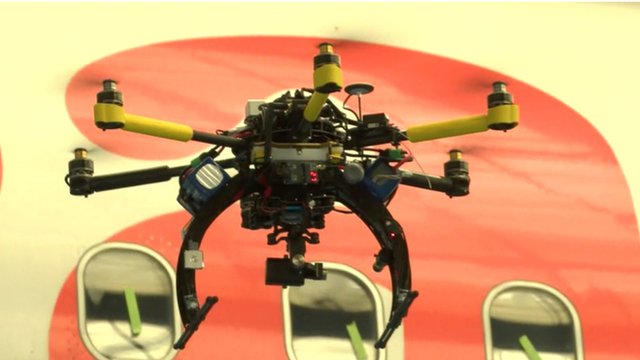Easyjet and BRL develop flying robots to inspect aircraft
Easyjet is developing drones to inspect its fleet of Airbus aircraft using technology from the Bristol Robotics Lab, reports BBC News, and may introduce the flying maintenance robots as early as next year.
The drones will be used to scan and assess Easyjet planes and report damage back to engineers.
“Aircraft inspection is a great application for drones,” said Dr Arthur Richards, head of aerial robotics at the Bristol Robotics Laboratory which is a collaboration between UWE and the University of Bristol. “Coupled with smart navigation and computer vision, they can get accurate data from really awkward places.”
Drone company Coptercraft in Berkshire and software company Measurement Solutions in Peterborough are also involved in the project.
The robot can be remotely controlled, but Easyjet wants to automate drone flights. They are fitted with high definition video cameras, but can also use lasers to scan the outside of the aircraft, Easyjet head of engineering Ian Davies told the BBC.
“We could zoom [the laser scanner] up and down the aircraft and map the surface,” he said. “If we’ve mapped the aeroplane we can have a complete history of its full life.”
He added that it is safer to have drones working at height than humans having to go up on a rig.
One of the main challenges for the drones is how to get them to work outside in windy conditions, Mr Richards said.
The drones are built to be light in weight, but that can make them vulnerable to gusts of wind on an airfield.
They plan to use research into how animals such as bees and birds cope with blustery weather to “see how nature solves the same problem”.
Another challenge is to automate drone flights, he added.
At the moment engineers and pilots email pictures and call Easyjet’s control centre to try to resolve issues over the phone, but Easyjet is planning to use hi-tech glasses that can relay high definition video images back to base.
Engineers could be directed to do repairs by a team looking at the video stream coming from the glasses, Mr Davies said. The technology also uses “augmented reality”, where a computer image is superimposed on the view as seen through the glasses.
For example, an engineer can compare an image of a fuselage projected onto the glasses with the actual fuselage, to see what work needs to be done.
At the moment, the data is transmitted using 4G, but Easyjet is discussing options for satellite links with communications company Iridium, Mr Davies said.
via BBC News – Easyjet develops flying robots to inspect aircraft.
Related articles
Comments
Tell me what you're thinking...
and oh, if you want a pic to show with your comment, go get a gravatar!






